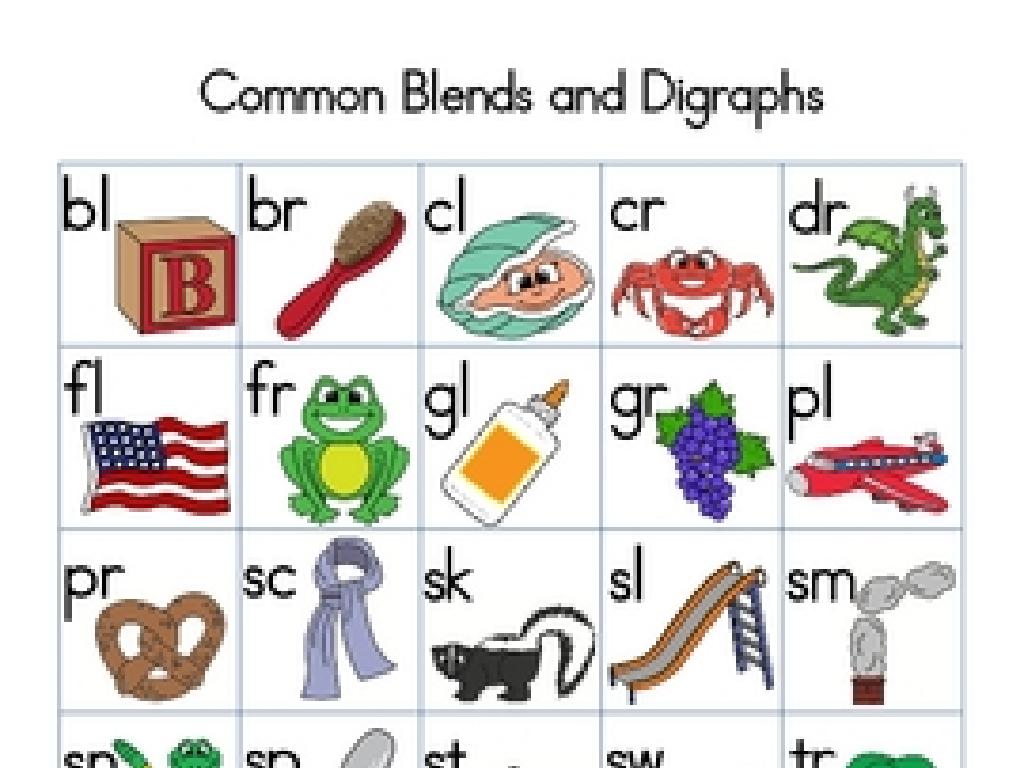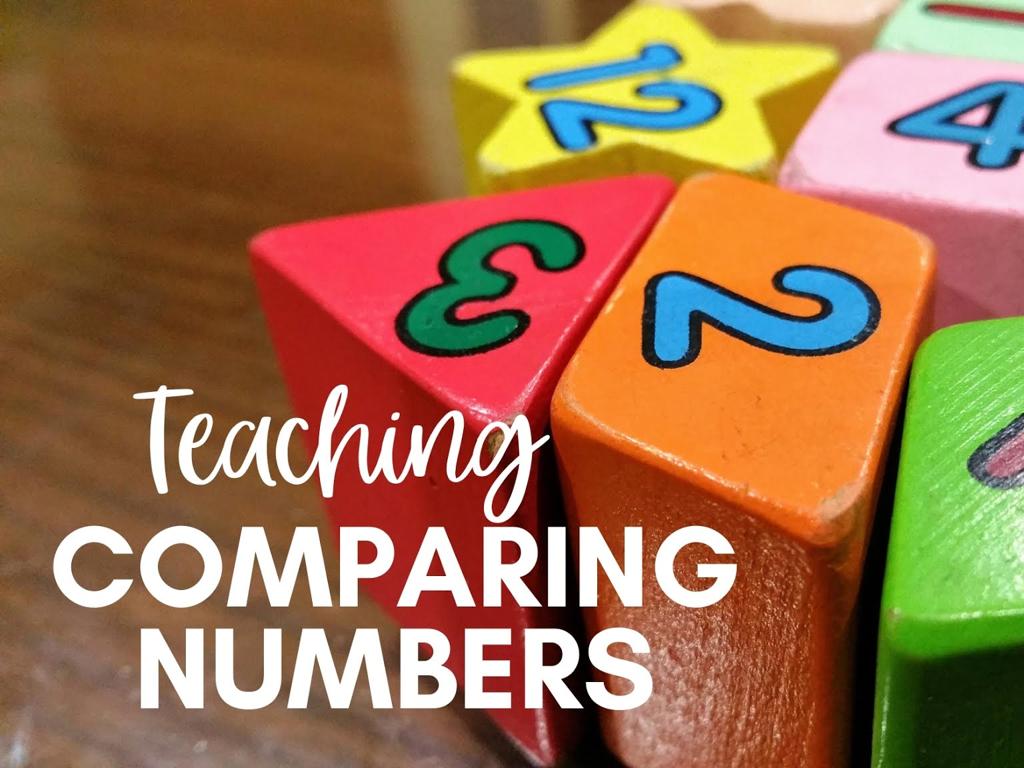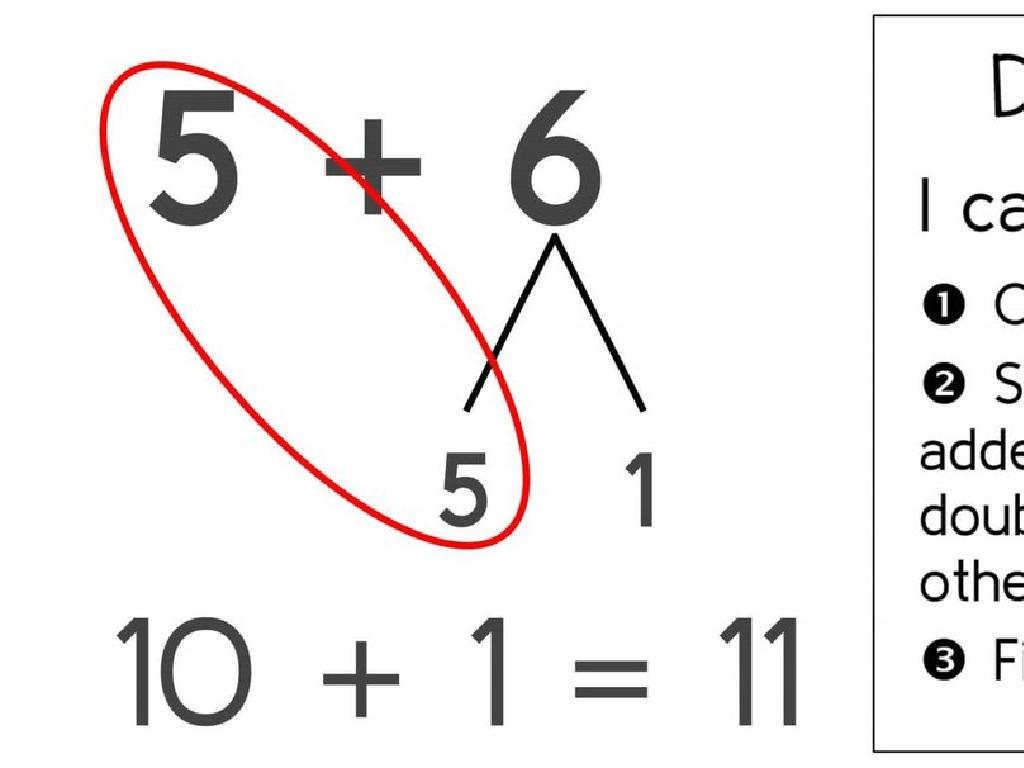Subtraction Sentences Up To 10: Which Model Matches?
Subject: Math
Grade: First grade
Topic: Understand Subtraction
Please LOG IN to download the presentation. Access is available to registered users only.
View More Content
Welcome to Subtraction!
– Learning to take away numbers
– Subtraction shows how many left
– If you have 5 apples and eat 2, subtraction tells you 3 are left.
– Practice with numbers up to 10
– We’ll subtract numbers 1 through 10, like 8 – 6 or 7 – 4.
– Match models to subtraction sentences
– We’ll use pictures and objects to understand our subtraction sentences.
|
This slide introduces first graders to the concept of subtraction as a means of determining how many items remain after some have been taken away. Emphasize that subtraction is simply ‘taking away’ and is used to find out the number of items left. Use relatable examples, such as apples, to illustrate this point. Encourage the students to think of subtraction as a fun activity, and reassure them that we will practice together with small numbers up to 10. Introduce the use of visual aids like pictures and physical objects to help them connect the subtraction sentences to real-life scenarios. The goal is to build a strong foundational understanding of subtraction through interactive and engaging methods.
Understanding Subtraction
– Subtraction means taking away
– Like when we have 5 toys and give 2 away
– Use a minus sign (-) for subtraction
– Example: 5 apples – 2 eaten
– Start with 5 apples, eat 2, and count what’s left
– How many apples are left?
– We can count the remaining apples together
|
This slide introduces the basic concept of subtraction to first graders. Begin by explaining subtraction as the process of taking away items from a group and highlight the use of the minus sign to represent this action. Use a simple and relatable example, such as having a certain number of apples and eating some, to illustrate how subtraction works in everyday life. Encourage the students to visualize the example by imagining the apples and the act of eating them. Ask the students to think of similar situations where they have a number of items and some are taken away, and then to determine what remains. This will help them understand the practical application of subtraction. Reinforce the concept by working through the example together and counting the remaining apples aloud as a class.
Understanding Subtraction Sentences
– Subtraction sentence structure
– A subtraction sentence includes numbers, a minus sign (-), and an equals sign (=).
– Minus sign and equals sign
– The minus sign shows something is taken away, and the equals sign shows the result.
– Example: 4 – 1 = 3
– Taking 1 away from 4 leaves us with 3.
|
This slide introduces the concept of subtraction sentences to first graders. Begin by explaining that a subtraction sentence is a way to show taking away using numbers and symbols. The minus sign (-) indicates that something is being taken away, and the equals sign (=) tells us what is left after the subtraction. Use simple examples like taking away blocks or toys to illustrate the concept. For instance, if there are 4 blocks and we take 1 away, we can count the remaining blocks to find the answer, which is 3. Encourage students to use their fingers or objects to practice creating their own subtraction sentences.
Matching Models to Subtraction Sentences
– Use objects to show subtraction
– Like using 5 toys and removing 2, showing 5 – 2
– Objects taken away are in the sentence
– If we take 1 toy away from 3 toys, our sentence is 3 – 1
– Match objects to subtraction sentences
– Find the sentence that fits taking away 2 from 4 toys
– Practice with examples together
– We’ll try subtracting using items in our classroom
|
This slide is aimed at helping first graders understand subtraction by using tangible objects such as toys or fingers to visualize the concept. Start by demonstrating subtraction with physical items, then guide students to relate the action of taking objects away to writing a subtraction sentence. Encourage the students to match the number of items they remove with the correct subtraction sentence. Engage the class with hands-on practice, using classroom items to create real examples. This interactive approach helps solidify their understanding of subtraction as ‘taking away’ and prepares them for more abstract mathematical concepts.
Let’s Practice Subtraction Together!
– Observe the subtraction model
– Write the subtraction sentence
– Count carefully when subtracting
– Example: 6 blocks – 2 blocks
– Starting with 6, take away 2, we get 4. So, 6 – 2 = 4
|
This slide is an interactive class activity designed to help first graders understand subtraction by visualizing and writing subtraction sentences. Display a model that shows a certain number of items, then remove some and ask the students to write the corresponding subtraction sentence. Emphasize the importance of counting carefully when items are taken away. Use concrete examples like blocks or other manipulatives that students can physically handle. For instance, show them 6 blocks, remove 2, and then ask them to write the subtraction sentence 6 – 2 = 4. Encourage students to verbalize their thought process as they count. This activity will help reinforce the concept of subtraction as ‘taking away’ and improve their ability to translate a visual model into a mathematical sentence.
Your Turn to Try: Match Models to Sentences
– Match models to subtraction sentences
– Observe pictures and write sentences
– Look at each picture, what is being taken away?
– Share your findings with the class
– Discuss with friends or family before sharing
– Practice makes perfect in subtraction
|
This slide is an interactive class activity designed to help first graders practice subtraction by matching visual models to written subtraction sentences. Provide students with a variety of pictures that illustrate simple subtraction scenarios within 10. Encourage them to carefully observe what is being taken away in each picture and to write the corresponding subtraction sentence. After completing the task, students should be ready to share their sentences with the class, fostering a collaborative learning environment. As a teacher, prepare to guide them through the process, correct any mistakes, and praise their efforts to reinforce learning. Possible activities include using objects like counters, drawing, or interactive whiteboard exercises.
Class Activity: Subtraction Bingo
– Let’s play Subtraction Bingo!
– Match models to subtraction sentences
– Find the model that shows the same subtraction as your card
– Mark matching models on your card
– Use counters or markers to cover the correct model
– A full row wins the game!
|
This interactive activity is designed to help first graders practice and reinforce their understanding of subtraction up to 10. Each student will receive a bingo card with different subtraction sentences. Display models of subtraction problems using objects or pictures. As each model is shown, students will determine if it matches a subtraction sentence on their card and mark it accordingly. The goal is to recognize and match the visual model to the corresponding subtraction sentence. The first student to complete a full row on their bingo card and call out ‘Bingo!’ wins. Possible variations of the activity could include playing for a full card, creating patterns, or playing in small groups. Ensure to have small prizes or positive reinforcements ready for winners to keep the activity engaging.
Becoming Subtraction Stars!
– Congratulations on learning subtraction!
– Subtraction shows us what’s left
– If you have 5 apples and eat 2, subtraction tells us 3 are left.
– Practice makes perfect
– The more you practice, the better you’ll get at knowing how many are left.
– You’re all subtraction stars!
|
This slide is meant to celebrate the students’ achievements in learning the basics of subtraction. It’s important to reinforce the concept that subtraction is a way to find out how many items remain after some are taken away. Encourage the students to continue practicing with different examples, and remind them that with practice, they will become more confident and skilled in solving subtraction problems. Celebrate their progress and encourage a positive mindset by calling them ‘subtraction stars’, which will motivate them to keep practicing and improving.






